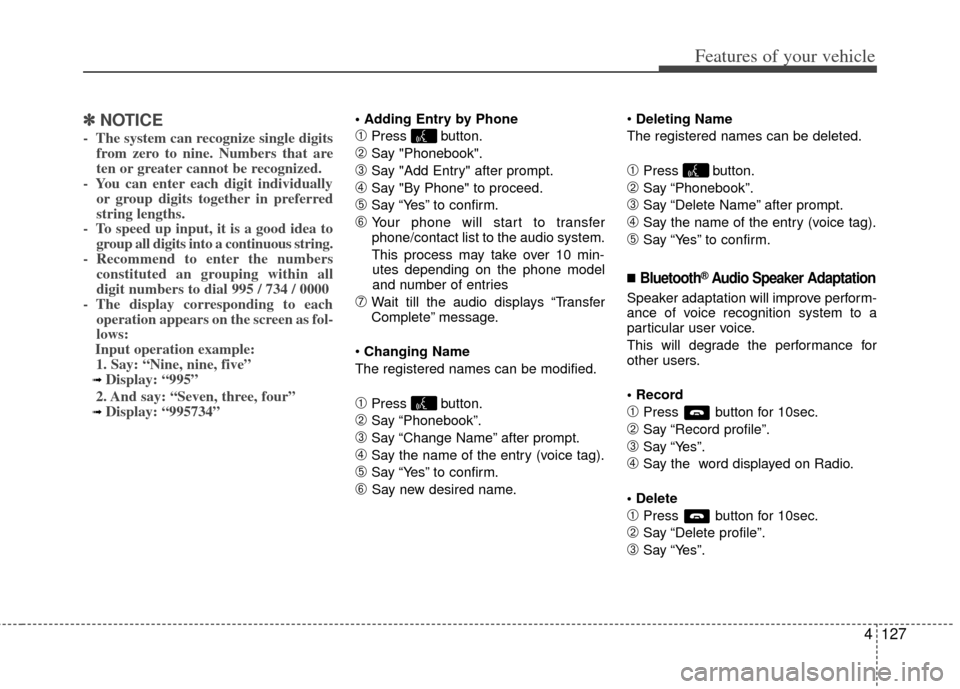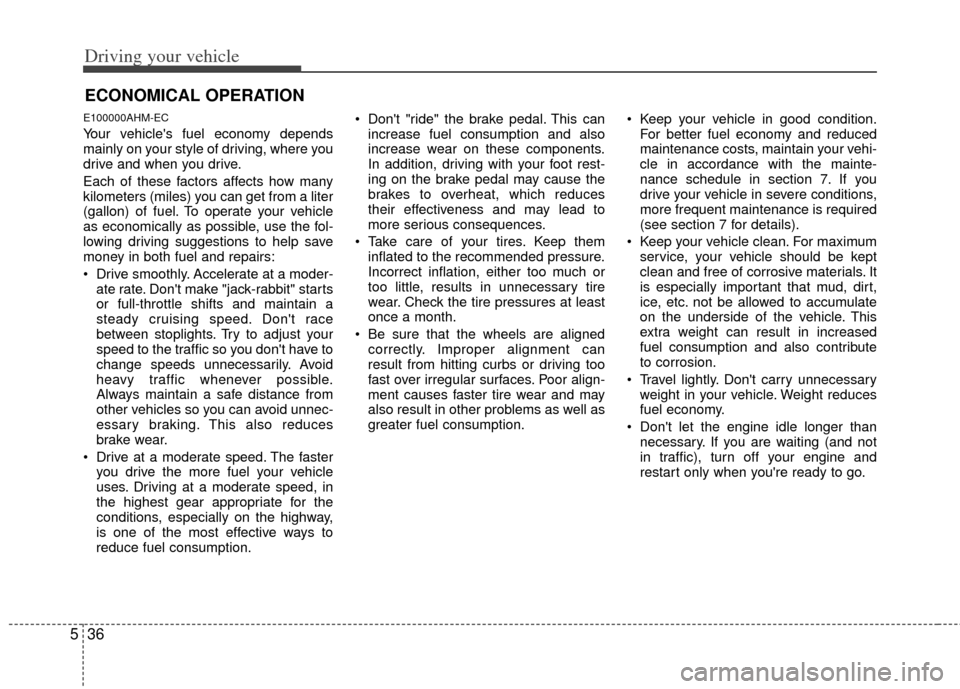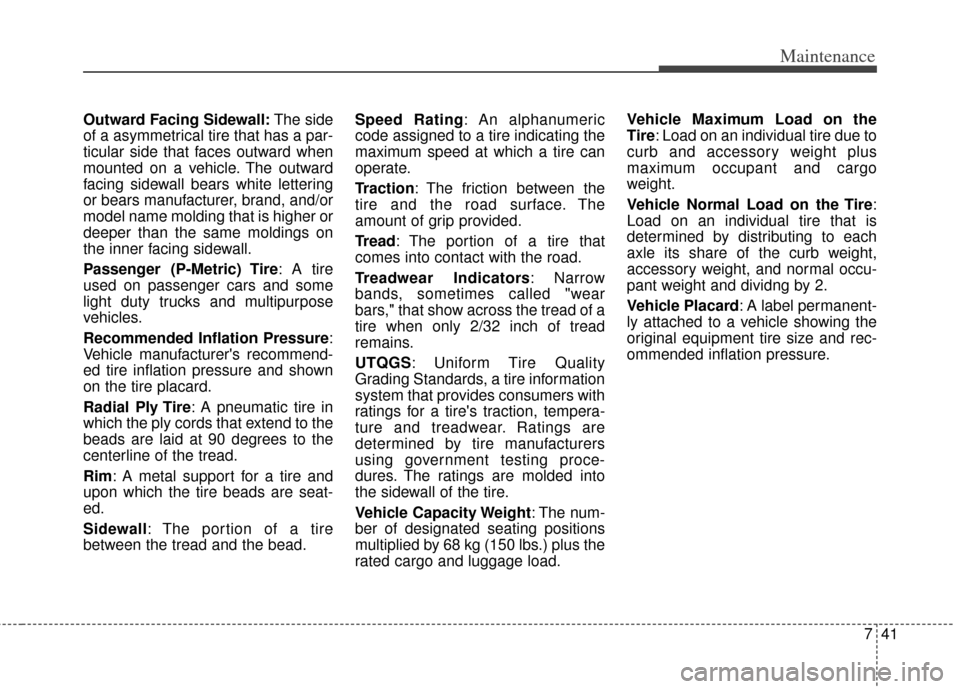2011 KIA Soul ECO mode
[x] Cancel search: ECO modePage 199 of 356

4127
Features of your vehicle
✽
✽NOTICE
- The system can recognize single digits
from zero to nine. Numbers that are
ten or greater cannot be recognized.
- You can enter each digit individually or group digits together in preferred
string lengths.
- To speed up input, it is a good idea to group all digits into a continuous string.
- Recommend to enter the numbers constituted an grouping within all
digit numbers to dial 995 / 734 / 0000
- The display corresponding to each operation appears on the screen as fol-
lows:
Input operation example: 1. Say: “Nine, nine, five”
➟ Display: “995”
2. And say: “Seven, three, four”
➟ Display: “995734”
\bPress button.
➁Say "Phonebook".
➂Say "Add Entry" after prompt.
➃Say "By Phone" to proceed.
\fSay “Yes” to confirm.
➅ Your phone will start to transfer
phone/contact list to the audio system.
This process may take over 10 min- utes depending on the phone model
and number of entries
➆Wait till the audio displays “Transfer
Complete” message.
Changing Name
The registered names can be modified.
\bPress button.
➁Say “Phonebook”.
➂Say “Change Name” after prompt.
➃Say the name of the entry (voice tag).
\fSay “Yes” to confirm.
➅ Say new desired name.
Deleting Name
The registered names can be deleted.
\bPress button.
➁Say “Phonebook”.
➂Say “Delete Name” after prompt.
➃Say the name of the entry (voice tag).
\fSay “Yes” to confirm.
■Bluetooth®Audio Speaker Adaptation
Speaker adaptation will improve perform-
ance of voice recognition system to a
particular user voice.
This will degrade the performance for
other users.
\bPress button for 10sec.
➁Say “Record profile”.
➂Say “Yes”.
➃Say the word displayed on Radio.
\bPress button for 10sec.
➁Say “Delete profile”.
➂Say “Yes”.
Page 237 of 356

Driving your vehicle
36
5
E100000AHM-EC
Your vehicle's fuel economy depends
mainly on your style of driving, where you
drive and when you drive.
Each of these factors affects how many
kilometers (miles) you can get from a liter
(gallon) of fuel. To operate your vehicle
as economically as possible, use the fol-
lowing driving suggestions to help save
money in both fuel and repairs:
Drive smoothly. Accelerate at a moder-
ate rate. Don't make "jack-rabbit" starts
or full-throttle shifts and maintain a
steady cruising speed. Don't race
between stoplights. Try to adjust your
speed to the traffic so you don't have to
change speeds unnecessarily. Avoid
heavy traffic whenever possible.
Always maintain a safe distance from
other vehicles so you can avoid unnec-
essary braking. This also reduces
brake wear.
Drive at a moderate speed. The faster you drive the more fuel your vehicle
uses. Driving at a moderate speed, in
the highest gear appropriate for the
conditions, especially on the highway,
is one of the most effective ways to
reduce fuel consumption. Don't "ride" the brake pedal. This can
increase fuel consumption and also
increase wear on these components.
In addition, driving with your foot rest-
ing on the brake pedal may cause the
brakes to overheat, which reduces
their effectiveness and may lead to
more serious consequences.
Take care of your tires. Keep them inflated to the recommended pressure.
Incorrect inflation, either too much or
too little, results in unnecessary tire
wear. Check the tire pressures at least
once a month.
Be sure that the wheels are aligned correctly. Improper alignment can
result from hitting curbs or driving too
fast over irregular surfaces. Poor align-
ment causes faster tire wear and may
also result in other problems as well as
greater fuel consumption. Keep your vehicle in good condition.
For better fuel economy and reduced
maintenance costs, maintain your vehi-
cle in accordance with the mainte-
nance schedule in section 7. If you
drive your vehicle in severe conditions,
more frequent maintenance is required
(see section 7 for details).
Keep your vehicle clean. For maximum service, your vehicle should be kept
clean and free of corrosive materials. It
is especially important that mud, dirt,
ice, etc. not be allowed to accumulate
on the underside of the vehicle. This
extra weight can result in increased
fuel consumption and also contribute
to corrosion.
Travel lightly. Don't carry unnecessary weight in your vehicle. Weight reduces
fuel economy.
Don't let the engine idle longer than necessary. If you are waiting (and not
in traffic), turn off your engine and
restart only when you're ready to go.
ECONOMICAL OPERATION
Page 321 of 356

741
Maintenance
Outward Facing Sidewall:The side
of a asymmetrical tire that has a par-
ticular side that faces outward when
mounted on a vehicle. The outward
facing sidewall bears white lettering
or bears manufacturer, brand, and/or
model name molding that is higher or
deeper than the same moldings on
the inner facing sidewall.
Passenger (P-Metric) Tire : A tire
used on passenger cars and some
light duty trucks and multipurpose
vehicles.
Recommended Inflation Pressure :
Vehicle manufacturer's recommend-
ed tire inflation pressure and shown
on the tire placard.
Radial Ply Tire : A pneumatic tire in
which the ply cords that extend to the
beads are laid at 90 degrees to the
centerline of the tread.
Rim: A metal support for a tire and
upon which the tire beads are seat-
ed.
Sidewall: The portion of a tire
between the tread and the bead. Speed Rating: An alphanumeric
code assigned to a tire indicating the
maximum speed at which a tire can
operate.
Traction: The friction between the
tire and the road surface. The
amount of grip provided.
Tread: The portion of a tire that
comes into contact with the road.
Treadwear Indicators: Narrow
bands, sometimes called "wear
bars," that show across the tread of a
tire when only 2/32 inch of tread
remains.
UTQGS: Uniform Tire Quality
Grading Standards, a tire information
system that provides consumers with
ratings for a tire's traction, tempera-
ture and treadwear. Ratings are
determined by tire manufacturers
using government testing proce-
dures. The ratings are molded into
the sidewall of the tire.
Vehicle Capacity Weight
: The num-
ber of designated seating positions
multiplied by 68 kg (150 lbs.) plus the
rated cargo and luggage load. Vehicle Maximum Load on the
Tire: Load on an individual tire due to
curb and accessory weight plus
maximum occupant and cargo
weight.
Vehicle Normal Load on the Tire
:
Load on an individual tire that is
determined by distributing to each
axle its share of the curb weight,
accessory weight, and normal occu-
pant weight and dividng by 2.
Vehicle Placard: A label permanent-
ly attached to a vehicle showing the
original equipment tire size and rec-
ommended inflation pressure.
Page 322 of 356

Maintenance
42
7
All season tires
KIA specifies all season tires on
some models to provide good per-
formance for use all year round,
including snowy and icy road condi-
tions. All season tires are identified
by ALL SEASON and/or M+S (Mud
and Snow) on the tire sidewall. Snow
tires have better snow traction than
all season tires and may be more
appropriate in some areas.
Summer tires
KIA specifies summer tires on some
models to provide superior perform-
ance on dry roads. Summer tire per-
formance is substantially reduced in
snow and ice. Summer tires do not
have the tire traction rating M+S
(Mud and Snow) on the tire side wall.
if you plan to operate your vehicle in
snowy or icy conditions. KIA recom-
mends the use of snow tires or all
season tires on all four wheels. Snow tires
If you equip your car with snow tires,
they should be the same size and
have the same load capacity as the
original tires. Snow tires should be
installed on all four wheels; other-
wise, poor handling may result.
Snow tires should carry 28 kPa (4
psi) more air pressure than the pres-
sure recommended for the standard
tires on the tire label on the driver's
side of the center pillar, or up to the
maximum pressure shown on the tire
sidewall, whichever is less.
Do not drive faster than 120 km/h (75
mph) when your vehicle is equipped
with snow tires.Radial-ply tires
Radial-ply tires provide improved
tread life, road hazard resistance and
smoother high speed ride. The radi-
al-ply tires used on this vehicle are of
belted construction, and are selected
to complement the ride and handling
characteristics of your vehicle.
Radial-ply tires have the same load
carrying capacity, as bias-ply or bias
belted tires of the same size, and use
the same recommended inflation
pressure. Mixing of radial-ply tires
with bias-ply or bias belted tires is
not recommended. Any combina-
tions of radial-ply and bias-ply or bias
belted tires when used on the same
vehicle will seriously deteriorate
vehicle handling. The best rule to fol-
low is: Identical radial-ply tires should
always be used as a set of four.
Longer wearing tires can be more
susceptible to irregular tread wear. It
is very important to follow the tire
rotation interval shown in this section
to achieve the tread life potential of
these tires. Cuts and punctures in
radial-ply tires are repairable only in
the tread area, because of sidewall
flexing. Consult your tire dealer for
radial-ply tire repairs.
Page 350 of 356

I3
Index
Child restraint system ··················\
··················\
················3-25Auto lock mode (Passenger seat belt) ··················\
·····3-28
Lower anchor system ··················\
··················\
············3-31
Tether anchor system··················\
··················\
·············3-30
Child-protector rear door lock ··················\
··················\
···4-16
Climate control system (Automatic) ··················\
···········4-77 Air conditioning ··················\
··················\
··················\
··4-83
Automatic heating and air conditioning··················\
··4-78
Manual heating and air conditioning ··················\
······4-69
Climate control system (Manual) ··················\
···············4-68 Air conditioning ··················\
··················\
··················\
··4-73
Heating and air conditioning··················\
··················\
·4-69
Climate control air filter ··················\
··················\
············4-75
Combined instrument, see instrument cluster ···············4-37
Compact spare tire ··················\
··················\
··················\
···6-23
Compact spare tire replacement ··················\
··················\
7-35
Coolant ··················\
··················\
··················\
··················\
···7-15
Cooling fluid, see engine coolant ··················\
················7-16
Crankcase emission control system ··················\
·············7-58
Cruise control system ··················\
··················\
················5-32
Cup holder ··················\
··················\
··················\
···············4-90
Curtain air bag ··················\
··················\
··················\
·········3-51
Dashboard, see instrument cluster ··················\
···············4-37
Defogging (Windshield) ··················\
··················\
············4-84
Defogging logic (Windshield) ··················\
··················\
···4-86
Defroster (Rear window) ··················\
··················\
···········4-67 Defrosting (Windshield) ··················\
··················\
············4-84
Dimensions ··················\
··················\
··················\
················8-2
Door locks··················\
··················\
··················\
················4-13
Central door lock switch ··················\
··················\
·······4-15
Child-protector rear door lock ··················\
················4-16
Drinks holders, see cup holders··················\
··················\
·4-90
Driver's air bag··············\
··················\
··················\
·············3-45
Driving at night··················\
··················\
··················\
········5-40
Driving in flooded areas ··················\
··················\
············5-41
Driving in the rain ··················\
··················\
··················\
···5-41
Economical operation ··················\
··················\
················5-36
Electric chromic mirror (ECM) ··················\
··················\
·4-33
Electronic stability control (ESC) ··················\
···············5-27
Emergency starting ··················\
··················\
··················\
····6-4 Jump starting ··················\
··················\
··················\
·········6-4
Push starting ··················\
··················\
··················\
··········6-5
Emergency tailgate safety release··················\
················4-18
Emergency towing ··················\
··················\
··················\
···6-27
Emergency while driving··················\
··················\
·············6-2
Emission control system ··················\
··················\
············7-58 Crankcase emission control system ··················\
········7-58
Evaporative emission control (including ORVR) System ··················\
··················\
··················\
··············7-58
Exhaust emission control system ··················\
············7-59
Engine compartment ··················\
··················\
············2-4, 7-2
Engine coolant ··················\
··················\
··················\
·········7-15
D
E
Page 354 of 356

I7
Index
Recommended lubricants and capacities ··················\
·······8-4Recommended SAE viscosity number··················\
······8-5
Remote keyless entry ··················\
··················\
··················\
·4-5
Road warning ··················\
··················\
··················\
·············6-2
Rocking the vehicle ··················\
··················\
··················\
·5-39
Roof rack ··················\
··················\
··················\
·················4-93\
Seat belts ··················\
··················\
··················\
··················\
3-12 Pre-tensioner seat belt ··················\
··················\
···········3-18
Seat belt - Driver's··················\
··················\
·················3-14\
Seat belt warning··················\
··················\
··················\
·3-14
Seat belts - Front passenger and rear seat ·················3-16\
Seat warmer ··················\
··················\
··················\
···············3-8
Seatback pocket ··················\
··················\
··················\
·········3-9
Seating capacity ··················\
··················\
··················\
·······5-46
Seats ··················\
··················\
··················\
··················\
·········3-2 Armrest ··················\
··················\
··················\
··················\
3-7
Folding the rear seat ··················\
··················\
················3-9
Front seat adjustment - manual ··················\
·················3-4
Headrest ··················\
··················\
··················\
·······3-5, 3-11
Rear seat adjustment ··················\
··················\
···············3-9
Seat warmer··················\
··················\
··················\
···········3-8
Seatback pocket··················\
··················\
··················\
·····3-9
Shift lock system ··················\
··················\
··················\
·····5-19
Side impact air bag ··················\
··················\
··················\
··3-49 Spare tire
Compact spare tire ··················\
··················\
················6-23
Removing and storing the spare tire ··················\
·······6-18
Smart key ··················\
··················\
··················\
··················\
·4-9
Smooth cornering··················\
··················\
··················\
·····5-40
Snow tires ··················\
··················\
··················\
·······5-43, 7-44
Special driving conditions ··················\
··················\
·········5-38 Driving at night ··················\
··················\
··················\
···5-40
Driving in flooded areas··················\
··················\
········5-41
Driving in the rain ··················\
··················\
·················5-41\
Hazardous driving conditions ··················\
·················5-38\
Highway driving··················\
··················\
··················\
··5-42
Reducing the risk of a rollover ··················\
···············5-38
Rocking the vehicle··················\
··················\
···············5-39
Smooth cornering ··················\
··················\
··················\
5-40
Speedometer··················\
··················\
··················\
·············4-38
Sports mode ··················\
··················\
··················\
·············5-18
Starting difficulties, see Engine will not start ·················6-3
Starting the engine ··················\
··················\
··················\
·····5-6
Steering wheel···············\
··················\
··················\
·············4-31 Horn··················\
··················\
··················\
··················\
···4-32
Power steering ··················\
··················\
··················\
·····4-31
Tilt steering ··················\
··················\
··················\
·········4-31
Storage compartment ··················\
··················\
·················4-87\
Center console storage ··················\
··················\
··········4-87
Glove box ··················\
··················\
··················\
············4-87
Luggage box ··················\
··················\
··················\
········4-88
Multi box ··················\
··················\
··················\
·············4-88
S